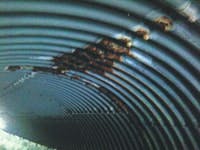Arched culverts made of bolted-together corrugated metal plates are a common feature in Ohio’s sewer infrastructure. “We have quite a few of them,” said Doug Gruver, P.E., a project engineer for the Ohio Department of Transportation (ODOT). “Overall, they really do their job; they have a decent lifespan, about 50 years minimum, and we’ve developed ways to extend that with different coatings, depending on the pH of the water and abrasiveness of the streambed material.”
Even so, there are many such culverts out there, and many have been in place for a long time. Even when performing optimally, culverts installed in the 1950s and ’60s have reached their design lifespan and are beginning to fail. Invert failure is most common, and relatively easy to fix; ODOT routinely paves failing metal inverts with concrete to extend culvert lifespans.
Rehabilitation of the arched portions is more difficult, though. These tend to fail around the boltholes and seams, especially in low-pH soils or where water seeps in from above. Rehabilitation of these upper arch portions have to be structural and waterproof, and, ideally—because arched culverts often run beneath busy roadways—they should be trenchless repairs without the need for large staging areas. ODOT has tried to spot repair failing arch culverts with an expanding foam product, and occasionally welds in rebar as a new structural member in failing areas. But neither of these solutions is completely satisfactory; they are not long lasting nor particularly structural, and they are not an effective approach for long pipe sections.
In 2013, ODOT approved a pilot project for the rehabilitation of twin arch culverts using a relatively new solution—the basic technology has been in use since 2007—based on CentriPipe technology developed by AP/M Permaform. “We wanted a more structural solution that could rehabilitate the entire structure and not continue to corrode,” Gruver said. “We’ve been hearing a lot about CentriPipe and other spray-applied structural lining techniques, and are very interested in how it will perform in this application.”
The culverts in question are quite large, about 12 ft 6 in. wide and 7 ft 11 in. tall, running for 90 ft under a two-lane rural road near Cincinnati. The inverts of both had previously failed and were paved with concrete, and there was significant rusting and leaking from the arched upper sections. This is common for large corrugated metal plate culverts in Ohio, so the pilot project would be a good test of the new solution.
Cementitious Grout
CentriPipe is a centrifugally cast concrete pipe solution typically applied to large-diameter round sewers from within by a patented, computer-controlled spincaster that is pulled through the pipe. In this case, because the sewer is arch-shaped and already had a reconstructed invert, a spraycaster was used to apply PL-8000, one of the cementitious grouts used in the process.
The basic idea of the process is to apply several thin layers of cementitious grout that adhere to the inside of the sewer. As the layers accrete—typically to a final design thickness of about 2 in.—they form a thin, structurally sound sewer within the original sewer. In this case, the new pipe was made of PL-8000, a fiber-reinforced cementitious grout that adheres to most sewer materials, including corrugated metal pipe and brick, and has high tensile strength. The grout in this project was supplemented by the contractor with Crystal-X, a waterproofing admixture from ConShield Technologies. It is important to note that the new pipe is a complete solution; if the surrounding arch culvert were somehow removed, the remaining concrete sewer still would be completely structurally sound and waterproof.
Dewatering the twin culverts was relatively easy. “We just diverted flow from one side to the other, which was convenient,” said Chris Wisehart, president of Indiana Reline, the contractor for the project. “Then we were able to work inside the culvert with one guy on the sprayer, and two handling the hoses.”
The most critical aspect of the process was meeting final design thickness, in this case, 2 in. To make sure that happened, Wisehart’s crew set hundreds of self-tapping screws into the metal plate, all of which protruded 2 in. above the culvert corrugations.
The new cementitious material is applied in several layers, no more than 1/2-in. thick—PL-8000 cures quickly, within a few hours, and bonds well to itself, so layers can be applied on successive days. With the pins in place, it was easy to keep layer thickness consistent, and when all the pins were completely covered, the 2-in. thickness was assured. Given the corrugations and an overlapping final layer, the new concrete culvert actually exceeded design in most of the pipe.
Staging for CentriPipe is minimal. An adjoining landowner permitted use of his land, and Indiana Reline set up a pump and mixer, bringing in pallets of material as needed—ultimately, about 40 pallets of PL-8000 were used. No traffic closures were required.
Preserving water quality presented a final challenge—ODOT asked that concrete and other waste not be permitted to flow downstream. Wisehart came up with a simple, elegant solution: Before spraying, he used plastic sheeting to line the paved inverts and then, with the final pass completed, he pulled them up before reintroducing flow.
Spraycasting and spincasting culvert interiors is a new approach for ODOT, but Gruver is optimistic. “We’ll have to ‘wait and see,’ of course, how well this holds up over time. But in the meantime we’ll be using the process again,” he said. “If it works as well as we expect, it will be a cost-effective solution and a way to avoid traffic closures.”
Download: Here

